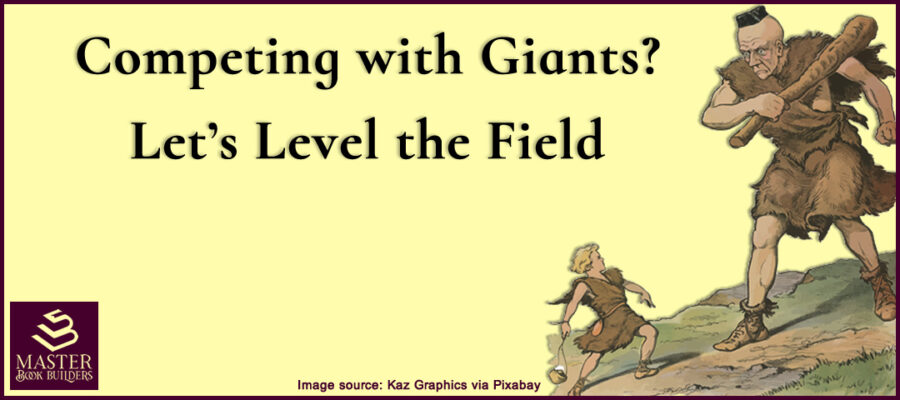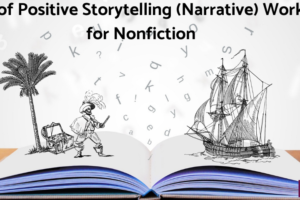[TfTi] Competing with Giants? Let’s Level the Field
In this edition of Tips from Tom’s inbox, I’m going to have to work at avoiding a rant. My goal is to help you understand and put to use some truths about book publishing and marketing as an indie author.
Two threads have popped up in my inbox over the past few months, most recently last week, with Rohit Bhargava’s “confession” in his Nonobvious Insights newsletter that he has paid (GASP!) for reviews of his best selling books (scroll to the fourth article). As he quickly points out, “Most authors have too, in one way or another.”
The second thread, besides the simple truth that book reviewers are often compensated, relates to the best seller lists themselves and a similar “confession” by best selling author Neil Patel in a LinkedIn video post that he “didn’t get on the New York Times Best Seller List because a lot of individuals bought the book” but by repeatedly convincing his connections at big corporations to buy bulk purchases of “$100,000, or $200,000, or $50,000 worth of books.”
These simple truths about how book marketing works — along with the music and film industries — have prompted some breathless “exposés” over the years. Okay, let me get my rant out of the way, so we can dig into why and how indie authors should put these realities to work in their book marketing efforts.
My Rant (short version)
Reviewers get compensated. And they deserve to be compensated. Does anyone think Siskel & Ebert worked for free?
The underlying problem lies in thinking that only celebrities or reviewers with syndicated columns deserve payment. Yvonne and I spent a good bit of our time during our BlogPaws years explaining to corporate pet brand managers that the pet bloggers who spend their time testing and writing honest reviews of their products were entitled to payment.
The same goes for book bloggers, bookstagrammers, and booktok-ers.
Conversely, indie authors (and filmmakers and musicians) deserve access to reviewers and best seller lists. When the giants price themselves out of the market, then alternative paths must be found.
Let’s talk about how these playing fields are being leveled.
Paying for Reviews (Part 1)
We’ll get the ethics question out of the way first. As Bhargava wrote,
“Paying for a review and paying for a positive review are two different things. One is certainly unethical. The other has become a necessity in many cases for independent artists.”
Before looking at this from your point of view as one of those independent artists, though, stop a moment and consider the reviewer.
That distinction between paying for a review and paying for a positive review was a constant part of our conversations with pet brands. When we started BlogPaws, Facebook was young and Instagram, TikTok, and so on didn’t yet exist, let alone dominate the social influencer landscape. Bloggers were the main target for social media reviews, so I’ll use them to represent all the non-celebrity influencers you might want to review your book nowadays.
What got lost in the pet brands’ thinking about their product and their relationship with the bloggers was the bloggers’ “product” (their writing) and, just as important, the bloggers’ relationship with their audience. Bloggers who care about what they’re doing care deeply about building a relationship of trust and confidence with their audience.
They are NOT selling a positive review. They are selling their time to try out your product — here that means the immensely valuable time to read your book — and their talent to craft an honest review, which in most cases will include both what they did and did not like.
But most importantly, they are renting you their credibility with their audience. In order to keep building their audience and writing reviews, they must guard that credibility with vigilance.
So, just like the professional (paid) reviewers at any big media outlet, the compensation bloggers get, from free product to a modest amount of money, is a fair and legitimate exchange.
The FTC rules around social media endorsements echo what should be the fundamental goal of both the reviewer and the author, that the review “must be honest and not misleading.” This, of course, means that if the reviewer receives payment in some form, that fact “should be disclosed clearly and conspicuously.”
Ignoring that goal of honesty will not only put both the author and the reviewer in legal jeopardy, over the long haul it will destroy the thing they should value most, their credibility as a writer.
Paying for Reviews (Part 2)
Now let’s get back to the other part of Bhargava’s statement, pointing out that paid reviews have become a necessity for independent artists. He queried whether you should just put your work out there and wait for it to get reviewed, because it’s a quality piece that will get noticed, right? He went on:
“Sadly not. Instead, the most well funded work or that with the biggest distribution or highest profile names attached gets the attention. Smaller independent artists and productions are just not noisy enough to break through.”
His examples of what does get noticed take us back to my title. You’re competing with giants. Do you think they are paying for reviews? (If not, go back and reread Part 1).
Yes, they are. Bhargava links to a very long article on Wired, with a telling title, Online Reviews Are Being Bought and Paid For. Get Used to It, that focuses mostly on the film industry and tells how major studios wine, dine, and jet film critics all over the world to get reviews (and of course also place ads in the media those critics are further paid by). As a reviewer himself, the author reiterates my point about the reviewer’s time that’s being paid for:
“Simply put, $50 isn’t enough to merit sinking hours into watching a movie you know is going to be bad and then writing about it.”
If you want more on the film industry, here’s a recent piece, How Studios Manipulate Rotten Tomatoes Scores To Their Advantage.
But way down in the Wired article under the subheading “Prior Art” the author spends some time comparing the book publishing industry and shows some ways that we can look to a few “friendly giants” to help level the playing field for indie authors.
He notes that both Publishers Weekly and Kirkus Reviews now have programs for indie authors to submit their books for review. The PW program, called BookLife Reviews, costs $399. To its FAQ page question, “Is a BookLife Review a paid review?” it answers:
“Yes, when you purchase a BookLife review you are paying for a detailed, honest review of your book, written by Publishers Weekly‘s expert reviewers. The reviewer’s first obligation is to you, the author and customer, and BookLife Reviews reviewers understand that authors are best served through thoughtful critical assessments of a book’s strengths and weaknesses.”
The Kirkus Indie program is similar and the fees start at $450. In case any authors undervalue their own credibility and think they’re paying for a postive review, Kirkus disabuses them of that notion:
“Kirkus Indie reviewers are experienced professionals who honestly and impartially evaluate the books they receive. The resulting reviews can be positive — even earning a Kirkus Star, one of the industry’s most revered designations — negative, or anywhere in between. What we do guarantee is a fair, unbiased assessment of your work and its potential in the marketplace.”
As noted above, the credibility of both the reviewer and the author are on the line and the payment does not change that. Kirkus values its own highly, as shown in the header image caption on that page:
“The most trusted voice in book reviews since 1933.”
There are many other paid options for indie authors to get reviews from social media influencers — we use some with our clients — and more keep emerging, so we keep our eyes and ears open and do our best to let our clients know the latest. But the goal here is to help you understand the tilted landscape and that there are some ways to push it back toward level.
The Best Seller Lists
The second thread I’ve seen a lot about lately complains about authors buying their way onto them. Once again, we need to look at this from two angles.
Many articles over the years have written in scandalized tones about how big budget publishers and authors buy their way onto the major media best seller lists, or get their corporate connections to help do so. And others have published step-by-step instructions for how to make the second-tier lists. I’m not providing links, because down in their instructions you often find bits like selling 5,000 copies in a single week, or paying a book marketing company upwards of $100,000.
If that’s in your budget, Google the subject and have at it.
The second angle comes from those who criticize Amazon’s Best Seller lists as being too easy to attain. I can only shake my head and wonder whether they’re elitists, who don’t like anyone gaining recognition who can’t afford the money to play the game the old way, or they just like doing things the hard way.
My goal here is leveling the playing field. And when it comes to bestseller recognition, Amazon is the BIG Friendly Giant in that space. Heck, Amazon is the big giant in most spaces, right?
While I grant that achieving best seller status on Amazon is not as hard, nor expensive, as the big media lists, there is nothing illegitimate about its lists. They use real sales data and update it in near-real-time.
What makes the Amazon lists accessible to indie authors are the sheer number of them, with a list for every book category. I’ve read estimates that Amazon uses over 16,000 categories for books.
By figuring out which of the many relevant categories are most “winnable” for your book, you can improve your chances of making it high on those lists, even to #1. In addition, you’re training the Amazon algorithms to pay attention to your book, even recommending it to buyers of other books in the categories where you’ve ranked well.
Once you achieve that best seller status, you can use it in all your marketing for your book and your professional bio. Just like those authors with a Big Five publishing house, or unlimited budgets, or lots of corporate connections, who paid their way onto a list.
Of course, you do still have to sell some books. And unlike the major media lists, buying author copies won’t help on Amazon and bulk purchases aren’t fully counted either. So you can’t just call up your corporate connections and ask them to buy $50,000 worth.
Because the categories are so diverse, however, with careful planning around your launch date, you can be pretty confident of driving enough sales to climb the lists in your chosen categories.
Zeroing in on those winnable categories is a bit of an art/science mix. You can make educated guesses by looking at the Best Seller lists on the categories relevant to your book’s genre and examine the #1 book in that category compared to its overall Amazon sales rank. In general, if a book is high in the category ranking, but has a relatively low overall sales rank, say lower than #100,000, then you know it won’t take too many actual book sales to compete in that category.
Just be aware that with 16,000+ categories to wander through, doing it manually it can be a time consuming endeavor, with little assurance that you’ve settled on your best category options.
We subscribe to services that make this searching a bit faster for our clients’ books, including in Amazon’s international marketplaces. And indie authors can pay to access some of these tools, if you really want to spend the time and money to DIY.
The point I’ve been making all along is about leveling the playing field, so you can compete with the giants who are out there paying for reviews and buying their places on best seller lists.
You still have to go out and play the game. You have to garner the reviews, plan and execute a launch that sells enough books. My hope is that knowing that there are paths for indie authors will encourage you to put in the effort, or find the help you need to make it happen.
And all this circles us back to credibility. Because the first step that we’ve assumed in this discussion is writing, editing, designing, and publishing a book worthy of those positive reviews and #1 rankings. Without that, the reviews won’t be positive and any high ranking achieved will be fleeting, at best.






1 Comment
Leave your reply.